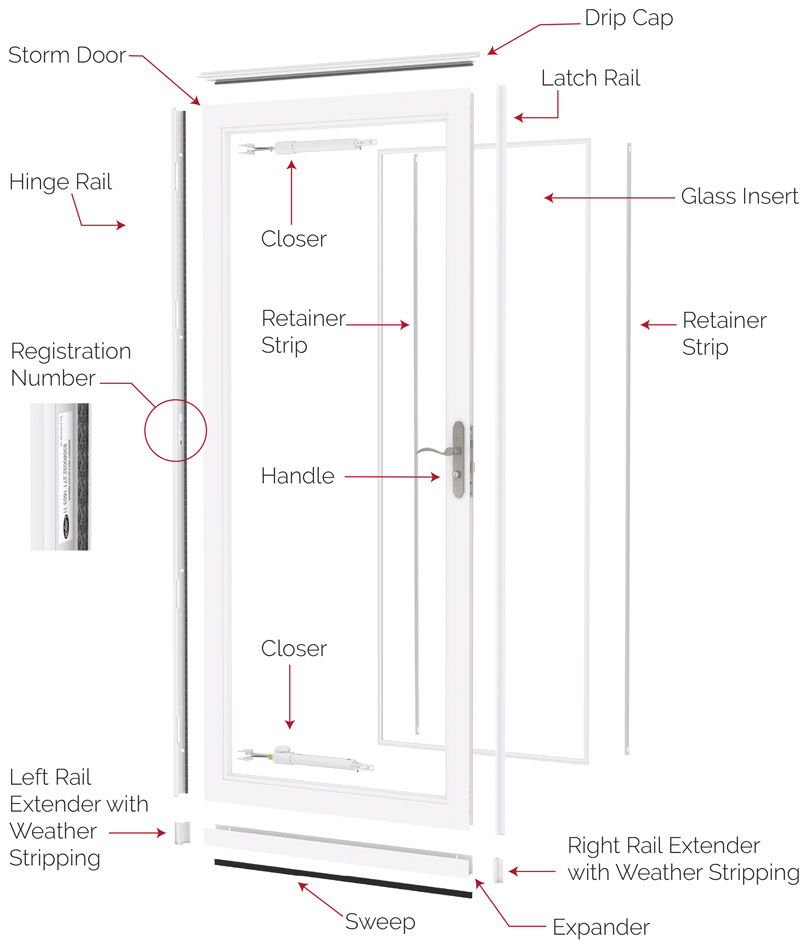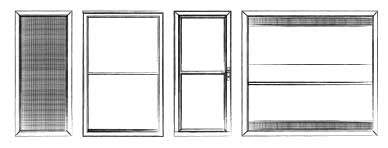A Larson storm door is a vital addition to any entryway, providing an extra layer of protection and ventilation. Knowing the anatomy of a storm door can help you identify the right features, understand its functionality and maintain its performance over time. From durable hardware to fullview designs, Larson storm door components are thoughtfully crafted to balance practicality with aesthetic appeal.
Storm Doors: A storm door is the second, outermost layer of a home's entrance, traditionally designed to protect against weather. Modern storm doors, like those offered by Larson, go beyond weather protection by helping to seal out drafts, reduce noise, provide ventilation, add natural light, keep bugs out and enhance curb appeal. Available in various styles, and colors, they combine functionality with visual appeal.
Closer: The storm door closer is designed to manage the door panel’s speed and movement, ensuring it closes gently and consistently. It shuts the door approximately 95% of the way, with the latch securing it fully. Many closers include convenient features like a hold-open washer or push-button option, allowing you to keep the door open while carrying groceries or moving items. Adjustable settings let you fine-tune the speed and force of closure, preventing slamming and adding convenience.
Drip Cap: The drip cap sits at the top of the Larson storm door, acting as a shield to redirect rainwater away from the door's surface. By preventing water from seeping into the frame, it helps protect against moisture damage and prolongs the life of the door. This simple yet essential feature is key to maintaining a dry and durable entryway.
Expander: The expander is positioned at the bottom of the storm door and is designed to be adjustable during installation. This feature ensures a precise fit against the threshold, enhancing the seal. A properly adjusted expander is essential for blocking drafts and helping to maintain energy efficiency.
Interchangeable Glass: The glass panel, unique to maximum view and fullview storm door designs, offers versatility and performance. During colder months, the full glass provides insulation and protection, while in warmer seasons, it can be replaced with a full screen for ventilation. Other storm door models may feature alternative glass configurations, allowing you to customize your door to suit your home's needs and the changing seasons.
Handleset: Depending on the Larson storm door you choose, your door may or may not include handles. The handleset is a critical piece of storm door hardware, ensuring smooth operation and secure closure. Selecting the right handleset complements both the style and functionality of your storm door.
Hinge Rail: The hinge rail forms part of the storm door frame, securing the door to the exterior door trim or other mounting surface. As a key component of storm door installation, it ensures the door is properly aligned and operates smoothly on its hinges.
Latch Rail: Attached to the handle-side exterior door trim or other mounting surface, the latch rail enables the storm door to close securely against the weatherstrip. This component is integral to storm door functionality, helping to keep out the elements and maintain a snug seal.
Left and Right Rail Extenders: Similar to the expander, rail extenders are adjustable components located at the bottom of the hinge and latch rails. These parts ensure the door fits precisely within its frame, improving performance and helping to prevent air or moisture from seeping in. Proper adjustment during installation is crucial for optimal storm door maintenance and longevity.
Registration Number: Every Larson storm door includes a unique registration number, an important feature for tracking its origin and model. This identification allows our team to provide tailored support for your storm door and will help you find replacement parts to maintain your door over time.
Retainer Strip: Found in Larson interchangeable storm doors, the retainer strips are plastic components that hold glass or screens firmly in place. These strips simplify the process of switching between glass and screen inserts and ensure a secure fit, supporting the door's overall durability and usability.
Extender Sweep: The extender sweep is a flexible rubber flap located at the bottom of the storm door, designed to seal the gap between the door and the threshold. This feature prevents moisture, dust and insects from entering your home, contributing to storm door functionality and ensuring a clean, comfortable interior.
Each part of a Larson storm door works together to provide protection, convenience and style for your home. Familiarizing yourself with these components helps ensure your storm door remains dependable and serves you well for years to come. Ready to upgrade? Explore our screen and storm doors and order parts online today at shop.larsondoors.com.
.png?width=800&height=202&name=Logo_Larson_Script_95k%20(1).png)




 CHAT WITH US
CHAT WITH US 888.483.3768
888.483.3768